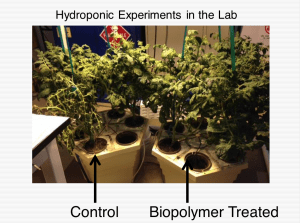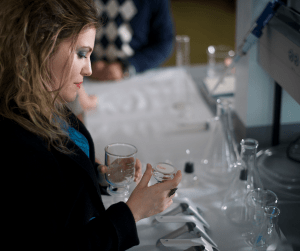In 2015, the Hunt Institute awarded Dr. Sevinc Sengor a seed grant to pursue research of a biopolymer compound, produced from Rhizobium tropici sp. In 2016, after Dr. Sengor was able to produce substantial evidence supporting its importance, she was awarded an EPA grant to further this research titled “Improving Cost Effectiveness & Stustainability of Agricultural Practices Through Innovative Biopolymer Treatment.”
Dr. Sengor’s research team is comprised of Mahdi Heidarizad, Jesse Hull, Deborah Oyedapo & Dr. Eva Csaky in collaboration with the US Army Corp of Engineers ERDC-EL research team. This team has been undertaking experiments which are carried out in a controlled laboratory environment using tomato plants, with three objectives: (i) to study the impact of the application of biopolymer compound, produced from Rhizobium tropici sp., on the growth of the tomato plants, to be measured based on the quantity and amount of tomatoes harvested, (ii) to measure the sugar and nutrient content of the fruits harvested to compare the nutritional attributes of the treatment and control groups, and (iii) to study the quality of the water circulating in the hydroponic system, to test the degree to which ammonium and other nutrients are removed from the water in the treatment and control groups.

This project was selected to be presented at the 2017 P3 National Sustainable Design Expo at Tech Connect. The conference and expo’s purpose is to be, “a global technology company. that serves as the critical link in what is often referred to as “the Global Innovation Pipeline” by working to bridge the divide between promising technologies and potential investors. This is done through a series of conferences, with the annual Tech Connect World Innovation Conference and Expo bringing together some of the greatest minds in the physical and life sciences.” The P3 (People, Prosperity, and the Planet) National Sustainable Design Expo (NSDE) was co-located with the Tech Connect Conference, allowing EPA P3 student projects to showcase their innovative ideas for a sustainable future alongside EPA programs, government agencies, and advanced tech companies.”
 According to the concluding remarks of Dr. Sengor’s presentation, the hydroponic experiments were carried out with tomato plants using .5% of biopolymer, compared against control. Water quality analysis showed slightly more P absorption by the biopolymer and no difference in others. Analysis of the tomatoes showed ~45% heavier tomatoes with higher sugar content (~18%). Root scan analysis showed larger root volume (~129%), surface area (~75%) and root length (~35%). Finally, the team concluded that further investigation of biopolymer for various crops for reduced fertilizer use with optimum efficiency is needed.
According to the concluding remarks of Dr. Sengor’s presentation, the hydroponic experiments were carried out with tomato plants using .5% of biopolymer, compared against control. Water quality analysis showed slightly more P absorption by the biopolymer and no difference in others. Analysis of the tomatoes showed ~45% heavier tomatoes with higher sugar content (~18%). Root scan analysis showed larger root volume (~129%), surface area (~75%) and root length (~35%). Finally, the team concluded that further investigation of biopolymer for various crops for reduced fertilizer use with optimum efficiency is needed.


